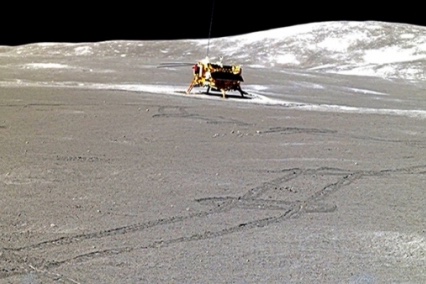
Left figure shows the antenna mounted on the back of Yutu-2 rover and wheel tracks of the rover.
Right one is the photo of Chang’e-4 lander taken by the panoramic camera on Yutu-2 rover.
Image credit: China National Space Administration (CNSA)
Yi Xu, an assistant professor of the State Key Laboratory of Lunar and Planetary Sciences at the Macau University of Science and Technology and her colleagues are core members of the scientific team of the Chang’e-4 mission. They present the first layered stratigraphic profile of the lunar farside at a depth between 50 to 330 m, based on data collected by the ground-penetrating radar onboard the Yutu-2 rover during the initial nine months of the exploration phase. The results provide direct evidence of multiple lava-infilling events having occurred within the Von Kármán crater. This work has been published on the latest Nature Communications issue.

Assistant Professor Yi Xu
On January 3rd 2019, the Chang’e-4 (CE-4) touched down on the Von Karman crater located inside the South Pole-Aitken (SPA) Basin on the lunar farside, a first in the history of lunar exploration. Yutu-2 rover was released subsequently, carrying a Ground-Penetrating Radar (GPR) to perform in-situ measurements of the lunar subsurface structure. Unravelling the shallow subsurface structure of a planetary body allows for a better understanding of its geologic history and the GPR has now proven its worth on two lunar missions. In the forthcoming Chinese “Tianwen-1” mission to Mars, a GPR will be also one of the key payloads onboard the Martian rover.
The corresponding author on behalf of all the coauthors would like to thank the China National Space Administration for providing valuable scientific data and for the support by the Science and Technology Development Fund (FDCT) of Macau.
The State Key Laboratory (SKL) of Lunar and Planetary Sciences based at the Macau University of Science and Technology is an active member of the Chinese Deep Space Exploration Program. As the only SKL in the field of astronomy and planetary science, researchers have been working on Chang’e missions and will participate in the data processing and analysis from the upcoming “Tianwen-1” mission to Mars. The laboratory will also be a key player in future Chinese missions to asteroids and the giant planets.






